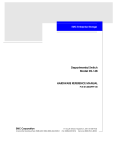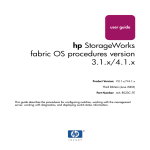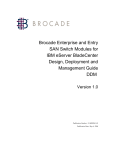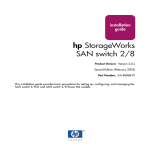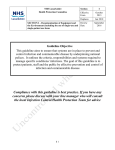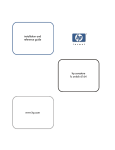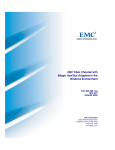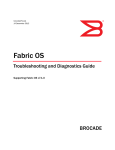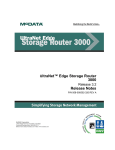Download EMC DS-16B2 User's Manual
Transcript
EMC Enterprise Storage Departmental Switch Model DS-16B2 Fabric OS Version 3.0 PROCEDURES MANUAL P/N 069001111-A01 EMC Corporation Corporate Headquarters: (508) 435-1000, (800) 424-EMC2 171 South Street, Hopkinton, MA 01748-9103 Fax: (508) 435-5374 Service: (800) SVC-4EMC Copyright © 2001 EMC Corporation. All rights reserved. Printed September, 2001 EMC believes the information in this publication is accurate as of its publication date. The information is subject to change without notice. THE INFORMATION IN THIS PUBLICATION IS PROVIDED “AS IS.” EMC CORPORATION MAKES NO REPRESENTATIONS OR WARRANTIES OF ANY KIND WITH RESPECT TO THE INFORMATION IN THIS PUBLICATION, AND SPECIFICALLY DISCLAIMS IMPLIED WARRANTIES OF MERCHANTABILITY OR FITNESS FOR A PARTICULAR PURPOSE. Use, copying, and distribution of any EMC software described in this publication requires an applicable software license. Regulatory Agency Information Departmental Switch Model DS-16B2 has been extensively tested and certified to meet UL1950, CSA 22.2 No 950, IEC 60950/EN60950; Safety of Information Technology Equipment including Electrical Business Equipment, FCC Rules Part 15 Subpart B; CISPR22 Class A; European EMC Directive 89/336/EEC on, electromagnetic compatibility. This class A digital apparatus complies with Canadian ICES-003. Cet appareil numérique de la classe A est conforme à la norme NMB-003 du Canada. Warning! This is a Class A product. In a domestic environment this product may cause radio interference in which case the user may be required to take adequate measures. Achtung! Dieses ist ein Gerät der Funkstörgrenzwertklasse A. In Wohnbereichen können bei Betrieb dieses Gerätes Rundfunkstörungen auftreten, in welchen Fällen der Benutzer für entsprechende Gegenmaßnahmen verantwortlich ist. Attention! Ceci est un produit de Classe A. Days un environment domestic, be produit risque de career des interferences radioélectriques, il appertained alors à l'utilisateur de prendre les mesures spécifiques appropriées. This equipment generates, uses, and may emit radio frequency energy. The equipment has been type tested and found to comply with the limits for a Class A digital device pursuant to Part 15 of FCC rules, which are designed to provide reasonable protection against such radio frequency interference. ii Departmental Switch DS-16B2 Fabric OS Procedures Manual Operation of this equipment in a residential area may cause interference in which case the user at his own expense will be required to take whatever measures may be required to correct the interference. Any modifications to this device - unless expressly approved by the manufacturer - can void the User authority to operate this equipment under part 15 of the FCC rules. Trademark Information EMC, EMC2, Symmetrix, and CLARiiON are registered trademarks and where information lives is a trademark of EMC Corporation. All other trademarks used herein are the property of their respective owners. Departmental Switch DS-16B2 Fabric OS Procedures Manual iii iv Departmental Switch DS-16B2 Fabric OS Procedures Manual Contents Preface .......................................................................................................................... vii Chapter 1 Setting the Initial Switch Configuration Logging In to a Switch .................................................................... 1-2 Enabling Licensed Features............................................................ 1-3 Displaying the Installed Feature Licenses.................................... 1-4 Changing the Admin Password and User ID .............................. 1-4 Configuring the IP Address ........................................................... 1-5 Displaying the Fabric-Wide Device Count................................... 1-6 Chapter 2 Basic Switch Configuration Procedures Setting the Telnet Timeout Value ................................................... 2-2 Displaying the Firmware Version.................................................. 2-2 Setting the Switch Date and Time.................................................. 2-3 Displaying the System Configuration Settings ........................... 2-4 Backing Up the System Configuration Settings .......................... 2-4 Restoring the System Configuration Settings.............................. 2-5 Upgrading or Restoring the Switch Firmware ............................ 2-6 Disabling a Switch ........................................................................... 2-6 Enabling a Switch ............................................................................ 2-7 Disabling a Port................................................................................ 2-7 Enabling a Port ................................................................................. 2-7 Changing a Switch Name ............................................................... 2-8 Setting the Switch Status Policy..................................................... 2-9 Viewing the Policy Threshold Values .................................... 2-9 Enabling the Track Changes Feature........................................... 2-10 Displaying Whether Track Changes is Enabled ................. 2-10 Configuring a Static Route Between Two Ports ........................ 2-11 Departmental Switch DS-16B2 Fabric OS Procedures Manual v Contents Displaying Help Information for a Telnet Command .............. 2-11 Reading Hexadecimal Port Diagrams ........................................ 2-12 Chapter 3 Displaying Error Logs and Status Displaying the Status of a Port ...................................................... Displaying Software Statistics for a Port............................... Displaying Hardware Statistics for a Port ............................ Displaying a Summary of Port Errors .......................................... Displaying the Error Log of a Switch ........................................... Displaying the Switch Status ......................................................... Displaying Information About a Switch ...................................... Displaying the Uptime of the Switch............................................ Displaying the Fan Status............................................................... Displaying Power Supply Status................................................... Displaying the Temperature Status............................................... Running Diagnostic Tests on the Switch Hardware ................... supportShow .................................................................................... Appendix A 3-2 3-2 3-2 3-3 3-4 3-4 3-5 3-6 3-6 3-7 3-8 3-8 3-8 Customer Support Overview of Detecting and Resolving Problems ...................... A-2 Troubleshooting the Problem ....................................................... A-3 Before Calling the Customer Support Center ............................ A-4 Documenting the Problem ........................................................... A-5 Reporting a New Problem ............................................................ A-6 Sending Problem Documentation ............................................... A-7 Glossary ........................................................................................................................ g-1 vi Departmental Switch Model DS-16B2 Fabric OS Procedures Manual Preface The Departmental Switch Model DS-16B2 Fabric OS Procedures Manual provides procedures for many of the basic tasks of administrating and configuring a DS-16B2 switch through the Telnet interface. For tasks related to specific features such as Zoning or QuickLoop, refer to the individual product guides. If a Departmental Switch Model DS-16B2 feature does not function properly or does not function as described in this manual, please contact the EMC Customer Support Center for assistance. Audience This manual is part of the Departmental Switch Model DS-16B2 documentation set, and is intended for use by administrators of the DS-16B2 switch. Readers of this manual are expected to be familiar with the following: Organization ◆ Departmental Switch Model DS-16B2 operating environment ◆ CLARiiON system operation Here is an overview of where information is located in this manual. ◆ Chapter 1, Setting the Initial Switch Configuration, provides information on initial configuration procedures including logging in and changing passwords. ◆ Chapter 2, Basic Switch Configuration Procedures, provides information on basic configuration procedures. ◆ Chapter 3, Working With the Management Server, provides information on working with the Management Server platform database. Departmental Switch DS-16B2 Fabric OS Procedures Manual vii Preface Related Documentation Conventions Used in this Manual ◆ Chapter 3, Displaying Error Logs and Status, provides instructions for displaying port and switch status information. ◆ Appendix A, Customer Support, describes the procedure for contacting EMC Corporation when you need help with the Departmental Switch Model DS-16B2. ◆ The Glossary provides explanations for terminology used in this manual. ◆ Departmental Switch Model DS-16B2 Hardware Reference Manual ◆ Departmental Switch DS-16B2 Fabric OS Reference Manual ◆ Departmental Switch DS-16B2 Management Information Base (MIB) Reference Manual ◆ Departmental Switch DS-16B2 Web Tools User Guide ◆ Departmental Switch DS-16B2 Zoning Reference Manual ◆ Departmental Switch DS-16B2 QuickLoop Reference Manual ◆ Departmental Switch DS-16B2 Fabric Watch Reference Manual ◆ Departmental Switch DS-16B2 Extended Fabric User Guide ◆ Departmental Switch DS-16B2 SCSI Enclosure Services (SES) Reference Manual ◆ Departmental Switch DS-16B2 Interswitch Link (ISL) Trunking User Guide ◆ Departmental Switch DS-16B2 Advanced Performance Monitoring User Guide ◆ Departmental Switch DS-16B2 Quick Start EMC uses the following conventions for notes, cautions, warnings, and danger notices. A note presents information that is important, but not hazard-related. ! CAUTION A caution contains information essential to avoid data loss or damage to the system or equipment. The caution may apply to hardware or software. viii Departmental Switch DS-16B2 Fabric OS Procedures Manual Preface WARNING A warning contains information essential to avoid a hazard that can cause severe personal injury, death, or substantial property damage if you ignore the warning. DANGER A danger notice contains information essential to avoid a hazard that will cause severe personal injury, death, or substantial property damage if you ignore the message. Typographical Conventions EMC uses the following type style conventions in this manual: AVANT GARDE Keystrokes Palatino, bold ◆ Palatino, italic ◆ ◆ ◆ ◆ Dialog box, button, icon, and menu items in text Selections you can make from the user interface, including buttons, icons, options, and field names New terms or unique word usage in text Command line arguments when used in text Book titles Courier, italic Arguments used in examples of command line syntax. Courier System prompts and displays and specific filenames or complete paths. For example: working root directory [/user/emc]: c:\Program Files\EMC\Symapi\db Courier, bold User entry. For example: symmpoll -p Departmental Switch DS-16B2 Fabric OS Procedures Manual ix Preface Where to Get Help Obtain technical support by calling your local sales office. For service, call: United States: (800) 782-4362 (SVC-4EMC) Canada: (800) 543-4782 (543-4SVC) Worldwide: (508) 497-7901 and ask for Customer Support. If you are located outside the USA, call the nearest EMC office for technical assistance. Sales and Customer Service Contacts For the list of EMC sales locations, please access the EMC home page at: http://www.emc.com/contact/ For additional information on the EMC products and services available to customers and partners, refer to the EMC Powerlink Web site at: http://powerlink.emc.com Your Comments x Your suggestions will help us continue to improve the accuracy, organization, and overall quality of the user publications. Please send a message to [email protected] with your opinions of this manual. Departmental Switch DS-16B2 Fabric OS Procedures Manual 1 Invisible Body Tag Setting the Initial Switch Configuration The Departmental Switch Model DS-16B2 requires a connection to your IP network. This chapter provides information on how to set up initial configuration tasks for a switch. ◆ ◆ ◆ ◆ ◆ ◆ Logging In to a Switch.......................................................................1-2 Enabling Licensed Features ..............................................................1-3 Displaying the Installed Feature Licenses ......................................1-4 Changing the Admin Password and User ID ................................1-4 Configuring the IP Address..............................................................1-5 Displaying the Fabric-Wide Device Count.....................................1-6 Setting the Initial Switch Configuration 1-1 Setting the Initial Switch Configuration 1 Logging In to a Switch The switch must be connected to an IP network through the RJ-45 port to enable a connection through Telnet. Refer to the Departmental Switch DS-16B2 Hardware Reference Manual for more information about connecting the switch to your IP network. To log into a Departmental Switch DS-16B2 switch: 1. Open a Telnet connection to the switch. The login prompt displays if the Telnet connection successfully found the switch in the network. The default IP address is 10.77.77.77 2. At the login prompt, enter the user ID that you use to login, for example: login: admin The password prompt displays if the user exists. 3. Enter the password for the user: password: xxxxxx The default password is password. If the login was successful, a prompt displays showing the name of the switch and user ID you are logged in as, for example: switch55:admin> 1-2 Departmental Switch Model DS-16B2 Fabric OS Procedures Manual Setting the Initial Switch Configuration Enabling Licensed Features Licensed features such as Departmental Switch DS-16B2 Fabric Watch, Departmental Switch DS-16B2 Extended Fabrics, and Departmental Switch DS-16B2 ISL Trunking are already loaded onto the switch firmware, but you must enable them with a license key. Once you purchase these features, you receive a key to unlock the feature. To enable a licensed feature: 1. Log in to the switch as the admin user. 2. At the command line, enter the following command: licenseAdd “aaaBbbCcc” where aaaBbbCcc is the license key for a particular feature. You must enter a license key to activate each feature. License keys are case sensitive. Enabling Licensed Features 1-3 1 Setting the Initial Switch Configuration 1 Displaying the Installed Feature Licenses To display what features have been enabled on a switch: 1. Log in to the switch as the admin user. 2. At the command line, enter the following command: licenseShow This command displays the license keys that have been entered for the switch and the features enabled by those licenses. Changing the Admin Password and User ID EMC® recommends that you change the admin user ID and system password the first time you log into the DS-16B2 Fabric operating system. To change the Admin user ID and password: 1. Login to the switch as the admin user. 2. At the command line, enter the following command: Password admin 3. An interactive session opens and prompts you for configuration values. a. At the New username prompt, enter a new name for the admin user. You can change the name of the admin user without changing the password. Press ENTER to leave the name as the default. b. At the Old Password prompt, enter the old password. c. At the New password prompt, enter the new password. The new password must be from 8 to 40 characters in length. d. At the Reenter new password prompt, enter the new password exactly as entered at the previous prompt. e. Press ENTER to commit the configuration to the firmware. 1-4 Departmental Switch Model DS-16B2 Fabric OS Procedures Manual Setting the Initial Switch Configuration Configuring the IP Address The Departmental Switch DS-16B2 switch is shipped with a default IP address of 10.77.77.77. To change the default IP Address and configure the Fibre Channel IP address of the switch: 1. Login to the switch as the admin user. 2. At the command line, enter the following command: ipAddrSet 3. An interactive session opens and prompts you for configuration values. a. Press ENTER without entering a value to skip over a prompt and leave the parameter value as the default. b. At the Ethernet IP Address prompt, enter the new IP address for the Ethernet port on the switch. Press ENTER to continue. c. At the Ethernet Subnetmask prompt, enter the address of the subnetmask, if applicable. Press ENTER to continue. d. At the Gateway Address prompt, enter the IP address of the gateway system if applicable. Press ENTER to continue. e. The configuration is then committed to the switch firmware. f. You are then prompted whether to make the IP address changes active now or at the next reboot. Enter y at the prompt to have the IP address changes take effect immediately. Configuring the IP Address 1-5 1 Setting the Initial Switch Configuration 1 Displaying the Fabric-Wide Device Count To verify that you have fabric-wide connectivity when you install a new switch, display the fabric-wide device count from the newly installed switch. To display the fabric-wide device count from a switch: 1. Login to the switch as the admin user. 2. At the command line, enter the following command: nsAllShow This command displays all the connected devices in the fabric. 1-6 Departmental Switch Model DS-16B2 Fabric OS Procedures Manual 2 Invisible Body Tag Basic Switch Configuration Procedures This chapter provides the following information on basic configuration tasks for Departmental Switch Model DS-16B2 switch. ◆ ◆ ◆ ◆ ◆ ◆ ◆ ◆ ◆ ◆ ◆ ◆ ◆ ◆ ◆ ◆ ◆ Setting the Telnet Timeout Value .....................................................2-2 Displaying the Firmware Version ....................................................2-2 Setting the Switch Date and Time....................................................2-3 Displaying the System Configuration Settings..............................2-4 Backing Up the System Configuration Settings ............................2-4 Restoring the System Configuration Settings ................................2-5 Upgrading or Restoring the Switch Firmware ..............................2-6 Disabling a Switch .............................................................................2-6 Enabling a Switch...............................................................................2-7 Disabling a Port ..................................................................................2-7 Enabling a Port ...................................................................................2-7 Changing a Switch Name .................................................................2-8 Setting the Switch Status Policy.......................................................2-9 Enabling the Track Changes Feature.............................................2-10 Configuring a Static Route Between Two Ports........................... 2-11 Displaying Help Information for a Telnet Command ................ 2-11 Reading Hexadecimal Port Diagrams...........................................2-12 Basic Switch Configuration Procedures 2-1 Basic Switch Configuration Procedures 2 Setting the Telnet Timeout Value To set a new Telnet timeout value: 1. Log in to the switch as the admin user. 2. At the command line, enter the following command: timeout x where x is the number of minutes before the Telnet connection times out. If you specify 0, then the connection never times out. Timeout is disabled by default. Displaying the Firmware Version To display the firmware version: 1. Log in to the switch as the admin user. 2. At the command line, enter the following command: version This command displays the Kernel version, DS-16B2 Fabric OS release number, and other information about the firmware. 2-2 Departmental Switch DS-16B2 Fabric OS Procedures Manual Basic Switch Configuration Procedures Setting the Switch Date and Time All switches maintain current date and time in nonvolatile memory. Date and time are used for logging events. Switch operation does not depend on the date and time; a switch with an incorrect date and time value still functions properly. To set the date and time of a switch: 1. Log in to the switch as the admin user. 2. At the command line, enter the following command: date "MMDDhhmmYY" where: MM is the month, valid values are 01-12. DD is the day, valid values are 01-31. hh is the hour, valid values are 00-23. mm is minutes, valid values are 00-59. YY is the year, valid values are 00-99. Year values greater than 69 are interpreted as 1970-1999; year values less than 70 are interpreted as 2000-2069. The date function does not support daylight savings time or time zones. Setting the Switch Date and Time 2-3 2 Basic Switch Configuration Procedures 2 Displaying the System Configuration Settings To display the system configuration settings: 1. Login to the switch as the admin user. 2. At the command line, enter the following command: configShow The system configuration settings displays. For more information on the system configuration settings, refer to the Departmental Switch Model DS-16B2 Fabric OS Reference Manual. Backing Up the System Configuration Settings Currently, only the RSHD.EXE and CAT.EXE utilities provide support for performing uploads for Windows hosts. Therefore, you must use FTP on Windows workstations to backup the system configuration, and the FTP service must be running before an upload can occur. To upload a backup copy of the configuration settings to a host computer: 1. Verify that the RSHD service (on UNIX hosts only) or the FTP service (on UNIX or Windows host) is running on the host workstation. 2. Log in to the switch as the admin user. 3. At the command line, enter the following command: configUpload hostIPaddr, user, path_filename, password 4. Press ENTER. The dialog box prompts you to enter the Host IP address, User Name, Filename, and password. All filenames/pathnames must be in UNIX syntax even if being executed from a Windows-based system (i.e., /temp/switch_2.txt). 2-4 Departmental Switch DS-16B2 Fabric OS Procedures Manual Basic Switch Configuration Procedures Restoring the System Configuration Settings To restore the system configuration settings from a backup: 1. Verify that the RSHD service (on UNIX hosts only) or the FTP service (on a UNIX or Windows host) is running on the host workstation. 2. Log in to the switch as the admin user. 3. Shut down the switch by entering the following command: switchDisable 4. At the command line, enter the following command: configDownload hostIPaddr, user, path_filename, password 5. Press ENTER. The dialog box prompts you to enter the Host IP address, User Name, Filename, and password. The password operand is only required if you are using FTP. 6. Reboot the switch by entering the following command: fastBoot Restoring the System Configuration Settings 2-5 2 Basic Switch Configuration Procedures 2 Upgrading or Restoring the Switch Firmware To upgrade or restore the switch firmware: 1. Verify that the RSHD service/utilities or the FTP service is running on the host workstation. 2. Log in to the switch as the admin user. 3. At the command line, enter the following command: firmwareDownload 4. Press ENTER. The system prompts you to enter the Host IP address, User Name, Filename, and password. The password operand is only required if you are using FTP. 5. Reboot the switch by entering the following command: fastBoot Disabling a Switch To disable a switch: 1. Log in to the switch as the admin user. 2. At the command line, enter the following command: switchDisable All Fibre Channel ports on the switch are taken offline. If the switch was part of a fabric, the remaining switches reconfigure. 2-6 Departmental Switch DS-16B2 Fabric OS Procedures Manual Basic Switch Configuration Procedures Enabling a Switch To enable a switch: 1. Log in to the switch as the admin user. 2. At the command line, enter the following command: switchEnable All Fibre Channel ports that passed the POST test are enabled. If the switch was part of a fabric, the switch rejoins the fabric. Disabling a Port To disable a port: 1. Log in to the switch as the admin user. 2. At the command line, enter the following command: portDisable portnumber where portnumber is the number of the port you want to disable. If the port is connected to another switch, the fabric may reconfigure. If the port is connected to one or more devices, these devices are no longer available to the fabric. Enabling a Port To enable a port: 1. Login to the switch as the admin user. 2. At the command line, enter the following command: portEnable portnumber where portnumber is the number of the port you want to enable. If the port is connected to another switch, the fabric may reconfigure. If the port is connected to one or more devices, these devices will become available on the fabric. Enabling a Switch 2-7 2 Basic Switch Configuration Procedures 2 Changing a Switch Name To change the name of a switch: 1. Log in to the switch as the admin user. 2. At the command line, enter the following command: switchName "new_name" where new_name is the new name for the switch. Switch names can be up to 19 characters long, must begin with a letter, and can contain letters, numbers, or the underscore character. 2-8 Departmental Switch DS-16B2 Fabric OS Procedures Manual Basic Switch Configuration Procedures Setting the Switch Status Policy There are seven parameters that determine the status of a switch: ◆ Number of faulty ports ◆ Missing GBICs (i.e., Small Form Factor Pluggable transceivers) ◆ Power supply status ◆ Temperature in enclosure ◆ Fan speed ◆ Port status ◆ sgroup ISL status Only one parameter needs to pass the MARGINAL or DOWN threshold to change the overall status of the switch. Do not modify these parameters unless so notified by EMC Customer Service. Viewing the Policy Threshold Values To view the switchStatusPolicy threshold values: 1. Log in to the switch as the admin user. 2. At the command line, enter the following command: switch:admin> switchStatusPolicyShow The current overall switch status policy parameters: Down Marginal ---------------------------------FaultyPorts 1 0 MissingGBICs 0 1 PowerSupplies 2 1 Temperatures 3 1 Fans 3 1 PortStatus 0 0 sgroup ISLStatus 2 1 Setting the Switch Status Policy 2-9 2 Basic Switch Configuration Procedures 2 Enabling the Track Changes Feature To enable the track changes feature: 1. Log in to the switch as the admin user. 2. At the command line, enter the following command: trackChangesSet 1 A prompt is displayed verifying that the track changes feature is on. The output from the track changes feature is dumped to the error log for the switch. Use the errdump command or errshow command to view the error log. Trackable changes are: • Successful login • Unsuccessful login • Logout • Config file change from task • Track changes on • Track changes off Items in the error log created from the Track changes feature are labeled Error TRACK. For example: Error 08 -------0x102cf710 (tShell): May 2 16:12:10 Error TRACK-LOGIN, 4, Successful login Displaying Whether Track Changes is Enabled To display the status of the track changes feature: 1. Log in to the switch as the admin user. 2. At the command line, enter the following command: trackChangesShow The status of the track changes feature is displayed as either on or off. This also displays whether the track changes feature is configured to send SNMP traps. For example: switch:admin> trackchangesshow Track changes status: ON Track changes generate SNMP-TRAP: NO 2-10 Departmental Switch DS-16B2 Fabric OS Procedures Manual Basic Switch Configuration Procedures Configuring a Static Route Between Two Ports To configure a static route between two ports: 1. Log in to the switch as the admin user. 2. At the command line, enter the following command: uRouteConfig port, domain, outputport where port is the port to be statically routed; can be either an F_Port or an E_Port. domain is the domain ID of the specified target switch, and outputport is the output port where traffic is to be forwarded. After you issue this command, and if outputport is a usable port, all frames coming in from a specified port addressed to the specified domain are routed through the specified outputport. If the outputport is not usable, the routing assignment is not affected. When outputport becomes usable the static route assignment for the port is enforced. Using static routes can affect load sharing. If a large number of routes are statically configured to the same output port, the ability of the switch to achieve optimum load sharing may be impaired. Displaying Help Information for a Telnet Command To display help information about a Telnet command: 1. Log in to the switch as the admin user. 2. At the command line, enter the following command: help command where command is the command name you would like help with. Configuring a Static Route Between Two Ports 2-11 2 Basic Switch Configuration Procedures 2 Reading Hexadecimal Port Diagrams Many of the commands return port diagrams in hexadecimal format. Example switch:admin> bcastShow Group Member Ports Member ISL Ports Static ISL Ports -----------------------------------------------------------256 0x00012083 0x00002080 0x00000000 To read the hexadecimal port diagrams, they must be converted into binary notation. Each hexadecimal value represents four binary values. Each hexadecimal value is converted into a group of four binary values that represent four ports as follows: Hex value = Binary value 0 = 0000 1 = 0001 2 = 0010 3 = 0011 4 = 0100 5 = 0101 6 = 0110 7 = 0111 8 = 1000 9 = 1001 A = 1010 B = 1011 C = 1100 D = 1101 E = 1110 F = 1111 2-12 Departmental Switch DS-16B2 Fabric OS Procedures Manual Basic Switch Configuration Procedures Once the hexadecimal is converted into a binary bit map, each bit represents a port, where a value of 1 means yes and a value of 0 means no. The bit map is read from right to left, that is, the least significant bit represents port 0. For example, if the member port value is displayed in hex as: 0 0000 0 0 0000 1 0000 2 0001 0 0010 8 3 0000 1000 0011 This corresponds to a binary bit map of the member ports as follows: This bit map displays the member ports as port 0, 1, 7, 13, and 16. Each switch has a hidden internal port (in the example above port 16) that is always a member of a broadcast group. Reading Hexadecimal Port Diagrams 2-13 2 Basic Switch Configuration Procedures 2 2-14 Departmental Switch DS-16B2 Fabric OS Procedures Manual 3 Invisible Body Tag Displaying Error Logs and Status This chapter provides the following information on displaying port and switch status information: ◆ ◆ ◆ ◆ ◆ ◆ ◆ ◆ ◆ ◆ Displaying the Status of a Port.........................................................3-2 Displaying a Summary of Port Errors.............................................3-3 Displaying the Error Log of a Switch..............................................3-4 Displaying the Switch Status............................................................3-4 Displaying Information About a Switch.........................................3-5 Displaying the Uptime of the Switch ..............................................3-6 Displaying the Fan Status .................................................................3-6 Displaying Power Supply Status .....................................................3-7 Displaying the Temperature Status .................................................3-8 Running Diagnostic Tests on the Switch Hardware .....................3-8 Displaying Error Logs and Status 3-1 Displaying Error Logs and Status 3 Displaying the Status of a Port There are two types of statistics you can view for a port: Displaying Software Statistics for a Port ◆ software statistics ◆ hardware statistics Software statistics for a port include information such as port state, number of interrupts, number of link failures, number of loss of synchronization warnings, and number of loss of signal warnings. To display the software statistics for a port: 1. Log in to the switch as the admin user. 2. At the command line, enter the following command: portShow portnumber where portnumber is the number of the port you want to view. A table of software statistics for the port displays. For more information on the portShow command, refer to the Departmental Switch Model DS-16B2 Fabric OS Reference Manual. Displaying Hardware Statistics for a Port Hardware statistics for a port include information such as number of frames received, number of frames sent, number of encoding errors received, and number of class 2 and 3 frames received. To display the hardware statistics for a port: 1. Log in to the switch as the admin user. 2. At the command line, enter the following command: portStatsShow portnumber where portnumber is the number of the port you want to view. A table of hardware statistics for the port displays. For more information on the portStatsShow command, refer to the Departmental Switch Model DS-16B2 Fabric OS Reference Manual. 3-2 Departmental Switch Model DS-16B2 Fabric OS Procedures Manual Displaying Error Logs and Status Displaying a Summary of Port Errors This command displays a summary of port errors for all the ports in a single switch. To display a summary of port errors for a switch: 1. Log in to the switch as the admin user. 2. At the command line enter the following command: portErrshow The display contains one output line per port. Table 4-1 explains the types of errors counted: Table 3-1 Error Summary Descriptions Error Type Description frames tx Frames transmitted. frames rx Frames received. enc in Encoding errors inside frames. crc err Frames with CRC errors. too shrt Frames shorter than minimum. too long Frames longer than maximum. bad eof Frames with bad end-of-frame delimiters. enc out Encoding error outside of frames. disc c3 Class 3 frames discarded. link fail Link failures (LF1 or LF2 states). loss sync Loss of synchronization. loss sig Loss of signal. frjt Frames rejected with F_RJT. fbsy Frames busied with F_BSY. Displaying a Summary of Port Errors 3-3 3 Displaying Error Logs and Status 3 For more information on the portErrShow command, refer to the Departmental Switch Model DS-16B2 Fabric OS Reference Manual. Displaying the Error Log of a Switch There are two ways to display the error log of a switch: ◆ Display the error log one page at a time ◆ Display the error log all at once To display the switch error log one page at a time: 1. Log in to the switch as the admin user. 2. At the command line, enter the following command: ErrShow To display the switch error log all at once: 1. Log in to the switch as the admin user. 2. At the command line, enter the following command: ErrDump Displaying the Switch Status The switch status can be Healthy/OK, Marginal/Warning, or Down. The overall status of a switch is determined by the status of several individual components within the switch. For more information on how the overall switch status is determined, refer to the switchStatusPolicySet command in the Departmental Switch Model DS-16B2 Fabric OS Reference Manual. To display the overall status of a switch: 1. Log in to the switch as the admin user. 2. At the command line enter the following command: switchStatusShow The status of the switch should be Healthy/OK. If the status is Marginal/Warning or Down, the components contributing to this status are displayed. 3-4 Departmental Switch Model DS-16B2 Fabric OS Procedures Manual Displaying Error Logs and Status Displaying Information About a Switch To display switch information: 1. Login to the switch as the admin user. 2. At the command line, enter the following command: switchShow This command displays the following information for a switch: • switchName — The name of the switch • switchType — The model and firmware version numbers of the switch • switchState — The Online, Offline, Testing, or Faulty state of the switch. • switchRole — The Principal, Subordinate, or Disabled role of the switch • switchDomain — The Domain ID of the switch. • switchId — The embedded port D_ID of the switch. • switchWwn — The World Wide Name of the switch. • switchBeacon — The beaconing state: either ON or OFF of the switch. This command also displays the following information for ports on the specified switch: • Module type — The SFP type if an SFP is present. • Port speed — The speed of the Port (1G, 2G, N1, N2, or AN). The speed can be fixed, negotiated, or auto negotiated. • Port state — The port status. • Comment — Displays information about the port. This can be blank or can include WWN for F_Port or E_Port, Trunking state, upstream, or downstream status. For more information, refer to the switchShow command in the Departmental Switch Model DS-16B2 Fabric OS Reference Manual. Displaying Information About a Switch 3-5 3 Displaying Error Logs and Status 3 Displaying the Uptime of the Switch To display the uptime for a switch: 1. Log in to the switch as the admin user. 2. At the command line, enter the following command: uptime This command displays: • The length of time the system has been in operation. • The total cumulative amount of up time since the system was first powered on. • The date and time of the last reboot. • The reason for the last reboot. • The reason for the last switch reboot is also recorded in the error log. Displaying the Fan Status To display the fan status of a switch: 1. Log in to the switch as the admin user. 2. At the command line, enter the following command: fanShow The possible values for fan status are: • OK — Fan is functioning correctly. • absent — Fan is not present. • below minimum — Fan is present but rotating too slowly or stopped. 3-6 Departmental Switch Model DS-16B2 Fabric OS Procedures Manual Displaying Error Logs and Status Displaying Power Supply Status To display the power supply status of a switch: 1. Login to the switch as the admin user. 2. At the command line enter the following command: psShow The possible values for power supply status are: • OK —Power supply present and functioning correctly. • absent — Power supply not present. • faulty — Power supply present but faulty (no power cable, power switch turned off, fuse blown, or other internal error). After the status line, a power supply identification line may be shown. If present, this line contains manufacture date, part numbers, serial numbers, and other identification information. Displaying Power Supply Status 3-7 3 Displaying Error Logs and Status 3 Displaying the Temperature Status To display the temperature status of a switch: 1. Login to the switch as the admin user. 2. At the command line enter the following command: tempShow This command displays current temperature readings from each of the five temperature sensors located on the main printed circuit board of the switch. The sensors are located, approximately, one in each corner and one at the center of the PCB. Running Diagnostic Tests on the Switch Hardware There are several diagnostic tests you can run on a switch. These tests are generally run during the POST, each time a switch is booted up. ◆ camtest ◆ centralMemoryTest ◆ cmemRetentionTest ◆ cmiTest ◆ crossPortTest ◆ portLoopbackTest ◆ sramRetentionTest ◆ turboRamTest ◆ statsTest ◆ spinSilk supportShow The supportShow command is used to gather switch information for debugging purposes. Your EMC Customer Service representative may ask you to run this command and capture the output. This information will aid Customer Service in diagnosing problems that could occur on the switch. 3-8 Departmental Switch Model DS-16B2 Fabric OS Procedures Manual Displaying Error Logs and Status Syntax Description supportShow [firstPort, lastPort, nLog] This command is available to all users. It has the effect of running each of the following commands one after the other in the following order: 1. version 2. tempShow 3. psShow 4. licenseShow 5. diagShow 6. errDump 7. switchShow 8. portFlagsShow 9. portErrShow 10. mqShow 11. portSemShow 12. portShow 13. portRegShow 14. portRouteShow 15. fabricShow 16. topologyShow 17. qlShow 18. nsShow 19. nsAllShow 20. cfgShow 21. onfigShow 22. faultShow 23. traceShow 24. portLogDump supportShow 3-9 3 Displaying Error Logs and Status 3 Operands This command has the following operands: firstPort Specify the first port, of a range of ports, to dump information. The default (if no operand specified) is to print state of port 0. If only firstPort is specified, only information for firstPort is printed. lastPort Specify the last port, of range of ports, to dump information. nLog Specify the number of lines of portLogDump to print: 0 = dump all lines (default) N = dump the last N lines <0 = skip portLogDump Example If firstPort is specified but lastPort is not specified, only firstPort information is printed for the port-based commands (portShow, portRegShow, portRouteShow). If no operand is supplied, firstPort is set to 0 and lastPort is set to maximum port of switch. sw7:admin> supportShow Kernel: 5.3.1 Fabric OS: v2.1 Made on: Tue Apr 6 16:57:22 PDT 1999 Flash: Thu Apr 1 10:23:43 PST 1999 BootProm: Thu Oct 1 13:34:29 PDT 1998 37 34 37 45 49 Centigrade 3-10 Departmental Switch Model DS-16B2 Fabric OS Procedures Manual A nvisible Body Tag Customer Support This appendix reviews the EMC process for detecting and resolving software problems, and provides essential questions that you should answer before contacting the EMC Customer Support Center. This appendix covers the following topics: ◆ ◆ ◆ ◆ ◆ ◆ Overview of Detecting and Resolving Problems .........................A-2 Troubleshooting the Problem ..........................................................A-3 Before Calling the Customer Support Center ...............................A-4 Documenting the Problem...............................................................A-5 Reporting a New Problem ...............................................................A-6 Sending Problem Documentation...................................................A-7 Customer Support A-1 Customer Support A Overview of Detecting and Resolving Problems EMC software products are supported directly by the EMC Customer Support Center in the United States. EMC uses the following process to resolve customer problems with its software products (Figure A-1). Problem Detection Refer to Technical Support Appendix in this Manual Collect Problem Information as Directed Contact the EMC Customer Support Center: (800) SVC-4EMC U.S.: Canada: (800) 543-4SVC Worldwide: (508) 497-7901 Confirm that the Problem is Software Related Call will be Directed to an EMC Software Support Engineer Problem is Tracked and Managed to Resolution Figure A-1 A-2 Problem Detection and Resolution Process Departmental Switch Model DS-16B2 Fabric OS Procedures Manual Customer Support Troubleshooting the Problem Please perform the relevant diagnostic steps before you contact the EMC Customer Support Center: 1. Read the documentation carefully. 2. Reconstruct the events leading up to the problem and describe them in writing. 3. Run some test cases to reproduce the problem. If you encounter a problem that requires technical programming or analysis, call the nearest EMC office or contact the EMC Customer Support Center at one of the following numbers: United States: (800) 782-4362 (SVC-4EMC) Canada: (800) 543-4782 (543-4SVC) Worldwide: (508) 497-7901 Please do not request a specific support representative unless one has already been assigned to your particular system problem. For additional information on the EMC products and services available to customers and partners, refer to the EMC Powerlink Web site at: http:/powerlink.emc.com Troubleshooting the Problem A-3 A Customer Support A Before Calling the Customer Support Center Have the following information available before calling the Customer Support Center or your support representative (if one has been assigned to you): ❑ Your company name ❑ Your name ❑ Your phone number ❑ For an existing problem, the problem tracking system ID, if one was previously assigned to the problem by a support representative A-4 Departmental Switch Model DS-16B2 Fabric OS Procedures Manual Customer Support Documenting the Problem If the EMC Customer Support Center requests information regarding the problem, please document it completely, making sure to include the following information: ❑ Your company name and address ❑ Your name ❑ Your telephone number ❑ The importance of the problem, so that it can be assigned a priority level To expedite the processing of your support request, you can photocopy this list and include it with the package. Documenting the Problem A-5 A Customer Support A Reporting a New Problem For a new problem, please provide the following information: ❑ Release level of the software that you are running ❑ Software installation parameters ❑ Host type on which you are running ❑ Operating system you are running and its release number ❑ Functions of the software that you are running ❑ Whether you can reproduce the problem ❑ Previous occurrences of the problem ❑ Whether the software has ever worked correctly ❑ Time period that the software did work properly ❑ Conditions under which the software worked properly ❑ Changes to your system between the time the software worked properly and the problem began ❑ Exact sequence of events that led to the system error ❑ Message numbers and complete text of any messages that the system produced ❑ Log file dated near the time the error occurred ❑ Results from tests that you have run ❑ Other related system output ❑ Other information that may help solve the problem A-6 Departmental Switch Model DS-16B2 Fabric OS Procedures Manual Customer Support Sending Problem Documentation Use one of the following methods to send documentation of the problem to the EMC Customer Support Center: ◆ E-mail ◆ FTP ◆ U.S. mail to the following address: EMC Customer Support Center 45 South Street Hopkinton, MA 01748-9103 If the problem was assigned a number or a specific support representative, please include that information in the address as well. Sending Problem Documentation A-7 A Customer Support A A-8 Departmental Switch Model DS-16B2 Fabric OS Procedures Manual Glossary The terms in the glossary relate to the switch and Fibre Channel connections. Many of these terms are used in this manual. A 8b/10b Encoding An encoding scheme that converts each 8 bit byte into 10 bits. Used to balance ones and zeros in high speed transports. Address Identifier A 24-bit value or 8-bit value used to identify the source or destination of a frame. Advanced Performance Monitoring A Brocade product that provides error and performance information to the administrator and end user for use in storage management. AL_PA Alias Address Identifier Arbitrated Loop Physical Address; a unique 8-bit value assigned during loop initialization to a port in an arbitrated loop. An address identifier recognized by a port in addition to its standard identifier. An alias address identifier may be shared by multiple ports. Alias AL_PA An AL_PA value recognized by an L_Port in addition to the AL_PA assigned to the port. See also AL_PA. Alias Server A fabric software facility that supports multicast group management. ANSI American National Standards Institute; the governing body for Fibre Channel standards in the U.S.A. Departmental Switch Model DS-16B2 Fabric OS Procedures Manual g-1 Glossary API Arbitrated Loop ASIC ATM AW_TOV Application Programming Interface; a defined protocol that allows applications to interface with a set of services. A shared 100 MBps Fibre Channel transport structured as a loop. Can support up to 126 devices and one fabric attachment. See also Topology. Application Specific Integrated Circuit. Asynchronous Transfer Mode; a transport used for transmitting data over LANs or WANs that transmit fixed length units of data. Provides any to any connectivity, and allows nodes to transmit simultaneously. Arbitration Wait Time Out Value; the minimum time an arbitrating L_Port waits for a response before beginning loop initialization. B Bandwidth The total transmission capacity of a cable, link, or system. Usually measured in bps (bits per second). May also refer to the range of transmission frequencies available to a network. See also Throughput. BB_Credit Buffer to buffer credit; the number of frames that can be transmitted to a directly connected recipient or within an arbitrated loop. Determined by the number of receive buffers available. See also Buffer-to -Buffer Flow Control and EE_Credit. Beginning Running Disparity The disparity at the transmitter or receiver when the special character associated with an ordered set is encoded or decoded. See also Disparity. BER Bit Error Rate; the rate at which bits are expected to be received in error. Expressed as the ratio of error bits to total bits transmitted. See also Error. Block Broadcast g-2 As applies to Fibre Channel, upper level application data that is transferred in a single sequence. The transmission of data from a single source to all devices in the fabric, regardless of zoning. See also Multicast and Unicast. Departmental Switch Model DS-16B2 Fabric OS Procedures Manual Glossary Buffer- to- Buffer Flow Control Management of the frame transmission rate in either a point to point topology or in an arbitrated loop. See also BB_Credit. C Cascade Chassis Two or more interconnected Fibre Channel switches. 2000-Series switches can be cascaded up to 239 switches, with a recommended maximum of seven interswitch links (no path longer than eight switches). See also Fabric and ISL. The metal frame in which the switch and switch components are mounted. Circuit An established communication path between two ports. Consists of two virtual circuits capable of transmitting in opposite directions. See also Link. Class 1 Service that provides a dedicated connection between two ports (also called connection oriented service), with notification of delivery or nondelivery. Class 2 Service that provides multiplex and connectionless frame switching service between two ports, with notification of delivery or nondelivery. Class 3 Service that provides a connectionless frame switching service between two ports, without notification of delivery or nondelivery of data. Can also be used to provide a multicast connection between the originator and recipients, with notification of delivery or nondelivery. Class F Connectionless service for control traffic between switches, with notification of delivery or nondelivery of data between the E_Ports. Class of Service Comma Community (SNMP) A specified set of delivery characteristics and attributes for frame delivery. A unique pattern (either 1100000 or 0011111) used in 8B/10B encoding to specify character alignment within a data stream. See also K28.5. A relationship between a group of SNMP managers and an SNMP agent, in which authentication, access control, and proxy characteristics are defined. See also SNMP. Departmental Switch Model DS-16B2 Fabric OS Procedures Manual g-3 Glossary CRC Cyclic Redundancy Check; a check for transmission errors included in every data frame. Credit As applies to Fibre Channel, the number of receive buffers available for transmission of frames between ports. See also BB_Credit and EE_Credit. Cut through A switching technique that allows the route for a frame to be selected as soon as the destination address is received. See also Route. D Data Word Type of transmission word that occurs within frames. The frame header, data field, and CRC all consist of data words. See also Frame, Ordered set, and Transmission Word. Defined Zone Configuration The set of all zone objects defined in the fabric. May include multiple zone configurations. See also Enabled Configuration and Zone Configuration. Disparity The relationship of ones and zeros in an encoded character. Neutral disparity means an equal number of each, positive disparity means a majority of ones, and negative disparity means a majority of zeros. DLS Dynamic Load Sharing; dynamic distribution of traffic over available paths. Allows for recomputing of routes when an Fx_Port or E_Port changes status. Domain ID As applies to Departmental Switches, a unique number between 1 and 239 that identifies the switch to the fabric and is used in routing frames. Usually automatically assigned by the switch, but can be manually assigned. E E_D_TOV E_Port g-4 Error Detect Time out Value; the minimum amount of time a target waits for a sequence to complete before initiating recovery. Can also be defined as the maximum time allowed for a round trip transmission before an error condition is declared. See also R_A_TOV and RR_TOV. Expansion Port; a type of switch port that can be connected to an E_Port on another switch to create an ISL. See also ISL. Departmental Switch Model DS-16B2 Fabric OS Procedures Manual Glossary EE_Credit End to end Credit; the number of receive buffers allocated by a recipient port to an originating port. Used by Class 1 and 2 services to manage the exchange of frames across the fabric between source and destination. See also End- to-end Flow Control and BB_Credit. EIA Rack A storage rack that meets the standards set by the Electronics Industry Association. Enabled Zone Configuration End-to-End Flow Control The currently enabled configuration of zones. Only one configuration can be enabled at a time. See also Defined Configuration and Zone Configuration. Governs flow of class 1 and 2 frames between N_Ports. See also EE_Credit. Error As applies to Fibre Channel, a missing or corrupted frame, time out, loss of synchronization, or loss of signal (link errors). See also Loop Failure. Exchange The highest level Fibre Channel mechanism used for communication between N_Ports. Composed of one or more related sequences, and can work in either one or both directions. Extended Fabrics A product that runs on Fabric OS and allows creation of a Fibre Channel fabric interconnected over distances of up to 100 kilometers. F F_Port Fabric Port; a port that is able to transmit under fabric protocol and interface over links. Can be used to connect an N_Port to a switch. See also FL_Port and Fx_Port. Fabric A Fibre Channel network containing two or more switches in addition to hosts and devices. May also be referred to as a switched fabric. See also Topology, SAN and Cascade. Fabric Name Fabric OS FC-AL-3 The unique identifier assigned to a fabric and communicated during login and port discovery. The proprietary operating system on switches. The Fibre Channel Arbitrated Loop standard defined by ANSI. Defined on top of the FC-PH standards. Departmental Switch Model DS-16B2 Fabric OS Procedures Manual g-5 Glossary FC-FLA FCP FC-PH-1, 2, 3 FC-PI Fibre Channel Protocol; mapping of protocols onto the Fibre Channel standard protocols. For example, SCSI FCP maps SCSI-3 onto Fibre Channel. The Fibre Channel Physical and Signalling Interface standards defined by ANSI. The Fibre Channel Physical Interface standard defined by ANSI. FC-PLDA The Fibre Channel Private Loop Direct Attach standard defined by ANSI. Applies to the operation of peripheral devices on a private loop. FC-SW-2 The second generation of the Fibre Channel Switch Fabric standard defined by ANSI. Specifies tools and algorithms for the interconnection and initialization of Fibre Channel switches in order to create a multi switch Fibre Channel fabric. Fibre Channel Transport Fill Word Firmware A protocol service that supports communication between Fibre Channel service providers. See also FSP. An IDLE or ARB ordered set that is transmitted during breaks between data frames to keep the Fibre Channel link active. The basic operating system provided with the hardware. FL_Port Fabric Loop Port; a port that is able to transmit under fabric protocol and also has arbitrated loop capabilities. Can be used to connect an NL_Port to a switch. See also F_Port and Fx_Port. FLOGI Fabric Login; the process by which an N_Port determines whether a fabric is present, and if so, exchanges service parameters with it. See also PLOGI. Frame The Fibre Channel structure used to transmit data between ports. Consists of a start of frame delimiter, header, any optional headers, the data payload, a cyclic redundancy check (CRC), and an end of frame delimiter. There are two types of frames: Link control frames (transmission acknowledgements, etc.) and data frames. FRU g-6 The Fibre Channel Fabric Loop Attach standard defined by ANSI. Field replaceable Unit; a component that can be replaced on site. Departmental Switch Model DS-16B2 Fabric OS Procedures Manual Glossary FS FSP FSPF Full Duplex Fx_Port Fibre Channel Service; a service that is defined by Fibre Channel standards and exists at a well known address. For example, the Simple Name Server is a Fibre Channel service. See also FSP. Fibre Channel Service Protocol; the common protocol for all fabric services, transparent to the fabric type or topology. See also FS. Fabric Shortest Path First; Brocade’s routing protocol for Fibre Channel switches. A mode of communication that allows the same port to simultaneously transmit and receive frames. See also Half Duplex. A fabric port that can operate as either an F_Port or FL_Port. See also F_Port and FL_Port. G G_Port Generic Port; a port that can operate as either an E_Port or F_Port. A port is defined as a G_Port when it is not yet connected or has not yet assumed a specific function in the fabric. GBIC Gigabit Interface Converter; a removable serial transceiver module that allows gigabaud physical level transport for Fibre Channel and gigabit ethernet. Gbps Gigabits per second (1,062,500,000 bits/second). GBps GigaBytes per second (1,062,500,000 bytes/second). H Half Duplex Hard Address HBA A mode of communication that allows a port to either transmit or receive frames at any time, but not simultaneously (with the exception of link control frames, which can be transmitted at any time). See also Full Duplex. The AL_PA that an NL_Port attempts to acquire during loop initialization. Host Bus Adapter; the interface card between a server or workstation bus and the Fibre Channel network. Departmental Switch Model DS-16B2 Fabric OS Procedures Manual g-7 Glossary Hub A Fibre Channel wiring concentrator that collapses a loop topology into a physical star topology. Nodes are automatically added to the loop when active and removed when inactive. I Idle Initiator Continuous transmission of an ordered set over a Fibre Channel link when no data is being transmitted, to keep the link active and maintain bit, byte, and word synchronization. A server or workstation on a Fibre Channel network that initiates communications with storage devices. See also Target. IOD In order Delivery; a parameter that, when set, guarantees that frames are either delivered in order or dropped. ISL Interswitch Link; a Fibre Channel link from the E_Port of one switch to the E_Port of another. See also E_Port and Cascade. ISL Trunking A Brocade feature that enables distribution of traffic over the combined bandwidth of up to four ISLs (between adjacent switches), while preserving in order delivery. A set of trunked ISLs is called a trunking group; each port employed in a trunking group is called a trunking port. See also Master Port. Isolated E_Port An E_Port that is online but not operational due to overlapping domain IDs or nonidentical parameters (such as E_D_TOVs). See also E_Port. IU Information Unit; a set of information as defined by either upper level process protocol definition or upper level protocol mapping. J JBOD Just a Bunch Of Disks; indicates a number of disks connected in a single chassis to one or more controllers. See also RAID. K K28.5 g-8 A special 10 bit character used to indicate the beginning of a transmission word that performs Fibre Channel control and signaling functions. The first seven bits of the character are the comma pattern. See also Comma. Departmental Switch Model DS-16B2 Fabric OS Procedures Manual Glossary L L_Port Loop Port; a node port (NL_Port) or fabric port (FL_Port) that has arbitrated loop capabilities. An L_Port can be in one of two modes: • Fabric mode-Connected to a port that is not loop capable, and using fabric protocol. • Loop mode- In an arbitrated loop and using loop protocol. An L_Port in loop mode can also be in participating mode or non participating mode. See also Nonparticipating Mode and Participating Mode. Latency Link Link Services The period of time required to transmit a frame, from the time it is sent until it arrives. As applies to Fibre Channel, a physical connection between two ports, consisting of both transmit and receive fibres. See also Circuit. A protocol for link related actions. LIP Loop Initialization Primitive; the signal used to begin initialization in a loop. Indicates either loop failure or resetting of a node. LM_TOV Loop Master Tim Out Value; the minimum time that the loop master waits for a loop initialization sequence to return. Loop Failure Loss of signal within a loop for any period of time, or loss of synchronization for longer than the time out value. Loop Initialization The logical procedure used by an L_Port to discover its environment. Can be used to assign AL_PA addresses, detect loop failure, or reset a node. Loop_ID A hex value representing one of the 127 possible AL_PA values in an arbitrated loop. Looplet LPSM A set of devices connected in a loop to a port that is a member of another loop. Loop Port State Machine; the logical entity that performs arbitrated loop protocols and defines the behavior of L_Ports when they require access to an arbitrated loop. Departmental Switch Model DS-16B2 Fabric OS Procedures Manual g-9 Glossary LWL Long Wavelength; a type of fiber optic cabling that is based on 1300mm lasers and supports link speeds of 1.0625 Gbps. May also refer to the type of GBIC or SFP. See also SWL. M Master Port MIB MIB Reference Manual Multicast Multimode As relates to trunking, the port that determines the routing paths for all traffic flowing through the trunking group. One of the ports in the first ISL in the trunking group is designated as the master port for that group. See also ISL Trunking. Management Information Base; an SNMP structure to help with device management, providing configuration and device information. A reference manual that provides descriptions and information about the different MIB types. The transmission of data from a single source to multiple specified N_Ports (as opposed to all the ports on the network). See also Broadcast and Unicast. A fiber optic cabling specification that allows up to 500 meters between devices. N N_Port Name Server NL_Port Node Node Name g-10 Node Port; a port on a node that can connect to a Fibre Channel port or to another N_Port in a point to point connection. See also NL_Port and Nx_Port. Frequently used to indicate Simple Name Server. See also SNS. Node Loop Port; a node port that has arbitrated loop capabilities. Used to connect an equipment port to the fabric in a loop configuration through an FL_Port. See also N_Port and Nx_Port. A Fibre Channel device that contains an N_Port or NL_Port. The unique identifier for a node, communicated during login and port discovery. Departmental Switch Model DS-16B2 Fabric OS Procedures Manual Glossary Nonparticipating Mode Nx_Port A mode in which an L_Port in a loop is inactive and cannot arbitrate or send frames, but can retransmit any received transmissions. This mode is entered if there are more than 127 devices in a loop and an AL_PA cannot be acquired. See also L_Port and Participating Mode. A node port that can operate as either an N_Port or NL_Port. O Ordered Set A transmission word that uses 8B/10B mapping and begins with the K28.5 character. Ordered sets occur outside of frames, and include the following items: • Frame delimiters mark frame boundaries and describe frame contents. • Primitive signals indicate events. • Primitive sequences indicate or initiate port states. Ordered sets are used to differentiate Fibre Channel control information from data frames and to manage the transport of frames. P Packet A set of information transmitted across a network. See also Frame. Participating Mode A mode in which an L_Port in a loop has a valid AL_PA and can arbitrate, send frames, and retransmit received transmissions. See also L_Port and Nonparticipating Mode. Path Selection The selection of a transmission path through the fabric. EMC switches use the FSPF protocol. Phantom Address An AL_PA value that is assigned to an device that is not physically in the loop. Also known as phantom AL_PA. Phantom Device PLOGI Point to point A device that is not physically in an arbitrated loop but is logically included through the use of a phantom address. Port Login; the port to port login process by which initiators establish sessions with targets. See also FLOGI. A Fibre Channel topology that employs direct links between each pair of communicating entities. See also Topology. Departmental Switch Model DS-16B2 Fabric OS Procedures Manual g-11 Glossary Port_Name POST The unique identifier assigned to a Fibre Channel port. Communicated during login and port discovery. Power On Self Test; a series of tests run by a switch after it is turned on. Private NL_Port An NL_Port that communicates only with other private NL_Ports in the same loop and does not log into the fabric. Private Device A device that supports arbitrated loop protocol and can interpret 8 bit addresses, but cannot log into the fabric. Private Loop Protocol Public NL_Port An arbitrated loop that does not include a participating FL_Port. A defined method and a set of standards for communication. An NL_Port that logs into the fabric, can function within either a public or a private loop, and can communicate with either private or public NL_Ports. Public Device A device that supports arbitrated loop protocol, can interpret 8 bit addresses, and can log into the fabric. Public Loop An arbitrated loop that includes a participating FL_Port, and may contain both public and private NL_Ports. Q QuickLoop A Brocade product that makes it possible to allow private devices within loops to communicate with public and private devices across the fabric through the creation of a larger loop. May also refer to the arbitrated loop created using this software. A QuickLoop can contain a number of devices or looplets; all devices in the same QuickLoop share a single AL_PA space. R R_A_TOV g-12 Resource Allocation Time out Value; the maximum time a frame can be delayed in the fabric and still be delivered. See also E_D_TOV and RR_TOV. Departmental Switch Model DS-16B2 Fabric OS Procedures Manual Glossary RAID Redundant Array of Independent Disks; a collection of disk drives that appear as a single volume to the server and are fault tolerant through mirroring or parity checking. See also JBOD. Request Rate The rate at which requests arrive at a servicing entity. See also Service Rate. Route As applies to a fabric, the communication path between two switches. May also apply to the specific path taken by an individual frame, from source to destination. See also FSPF. Routing The assignment of frames to specific switch ports, according to frame destination. RR_TOV Resource Recovery Time out Value; the minimum time a target device in a loop waits after a LIP before logging out a SCSI initiator. See also E_D_TOV, R_A_TOV. RSCN Registered State Change Notification; a switch function that allows notification of fabric changes to be sent from the switch to specified nodes. S SAN Storage Area Network; a network of systems and storage devices that communicate using Fibre Channel protocols. See also Fabric. Sequence A group of related frames transmitted in the same direction between two N_Ports. Service Rate The rate at which an entity can service requests. See also Request Rate. SES A Brocade product that runs on Fabric OS and allows monitoring, configuring, and maintenance of the Departmental Switch family using SCSI 3 Enclosure Services. SFP Small Form Factor Pluggable; optical transceiver used to convert signals between optical fiber cables and switches. SI Single Mode Sequence Initiative. The fiber optic cabling standard that corresponds to distances of up to 10 km between devices. Departmental Switch Model DS-16B2 Fabric OS Procedures Manual g-13 Glossary SNMP Simple Network Management Protocol. An internet management protocol that uses either IP for network level functions and UDP for transport level functions, or TCP/IP for both. Can be made available over other protocols, such as UDP/IP, because it does not rely on the underlying communication protocols. See also Community (SNMP). SNS Simple Name Server; a switch service that stores names, addresses, and attributes for up to 15 minutes, and provides them as required to other devices in the fabric. SNS is defined by Fibre Channel standards and exists at a well known address. May also be referred to as directory service. See also FS. Switch Hardware that routes frames according to Fibre Channel protocol and is controlled by software. Switch Name Switch Port SWL The arbitrary name assigned to a switch. A port on a switch. Switch ports can be E_Ports, F_Ports, or FL_Ports. Short Wavelength; a type of fiber optic cabling that is based on 850mm lasers and supports 1.0625 Gbps link speeds. May also refer to the type of GBIC or SFP. See also LWL. T Target Tenancy The time from when a port wins arbitration in a loop until the same port returns to the monitoring state. Also referred to as loop tenancy. Throughput The rate of data flow achieved within a cable, link, or system. Usually measured in bps (bits per second). See also Bandwidth. Topology g-14 A storage device on a Fibre Channel network. See also Initiator. As applies to Fibre Channel, the configuration of the Fibre Channel network and the resulting communication paths allowed. There are three possible topologies: • Point-to-point — A direct link between two communication ports. • Switched fabric — Multiple N_Ports linked to a switch by F_Ports. • Arbitrated loop — Multiple NL_Ports connected in a loop. Departmental Switch Model DS-16B2 Fabric OS Procedures Manual Glossary Translative Mode A mode in which private devices can communicate with public devices across the fabric. Transmission Character A 10 bit character encoded according to the rules of the 8B/10B algorithm. Transmission Word Trap (SNMP) Trunking Tunneling A group of four transmission characters. The message sent by an SNMP agent to inform the SNMP management station of a critical error. See also SNMP. See ISL Trunking. A technique for enabling two networks to communicate when the source and destination hosts are both on the same type of network, but are connected by a different type of network. U U_Port Universal Port; a switch port that can operate as a G_Port, E_Port, F_Port, or FL_Port. A port is defined as a U_Port when it is not connected or has not yet assumed a specific function in the fabric. UDP User Datagram Protocol; a protocol that runs on top of IP and provides port multiplexing for upper level protocols. ULP Upper-level Protocol; the protocol that runs on top of Fibre Channel. Typical upper-level protocols are SCSI, IP, HIPPI, and IPI. ULP_TOV Unicast Upper level Tim Out Value; the minimum time that a SCSI ULP process waits for SCSI status before initiating ULP recovery. The transmission of data from a single source to a single destination. See also Broadcast and Multicast. W Web Tools Well Known Address A Brocade product that runs on Fabric OS and provides a graphical interface to allow monitoring and management of individual switches or entire fabrics from a standard workstation. As pertaining to Fibre Channel, a logical address defined by the Fibre Channel standards as assigned to a specific function, and stored on the switch. Departmental Switch Model DS-16B2 Fabric OS Procedures Manual g-15 Glossary Workstation WWN A computer used to access and manage the fabric. May also be referred to as a management station or host. World Wide Name; an identifier that is unique worldwide. Each entity in a fabric has a separate WWN. Z g-16 Zone A set of devices and hosts attached to the same fabric and configured as being in the same zone. Devices and hosts within the same zone have access permission to others in the zone, but are not visible to any outside the zone. See also Zoning. Zone Configuration A specified set of zones. Enabling a configuration enables all zones in that configuration. See also Defined Configuration and Enabled Configuration. Zoning A Brocade product that runs on Fabric OS and allows partitioning of the fabric into logical groupings of devices. Devices in a zone can only access and be accessed by devices in the same zone. See also Zone. Departmental Switch Model DS-16B2 Fabric OS Procedures Manual
































































